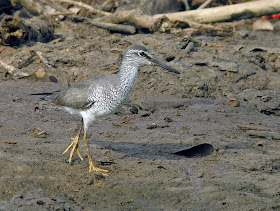
What IS he going on about? Participants trying not to laugh at my attire - a cross between commando and Englishman-with hanky-on-head-at-the-beach!

Getting good views and notes on a - no, not a green rubbish bin - an Intermediate Egret just beyond the green rubbish bin.


The bird after the egret was a nice surprise - a breeding plumaged Grey-tailed Tattler.

The lagoon near the Billionth Barrel Monument at Seria held a variety of roosting waterbirds, but also showed evidence of degradation. The vegetated fringe had recently been cleared right to the waterline.

The few roosting waders were a little difficult to view in the harsh light, but we were able to grapple with the differences between the Plover and Sandpiper family with these helpful Pacific Golden Plovers and Common Redshank.

This Yellow Bittern was entertaining to watch as it switched its tail from side to side to lure fish within striking distance.

Our second field trip was to Tutong Sewage works, where the presence of about 170 egrets of 4 species and a small number of Oriental Darters gave just about the right level of challenge for first-time counters.

We did it! Another batch of AWC volunteers trained and 'battle-ready' for AWC 2011!

After the end of the workshop and before my flight the following day, I managed to revisit Sg Seria to photograph some of its inhabitants, including two Chinese Egrets in breeding plumage.

The IUCN Red List estimates that there are no more than 3,400 of these stunning birds left in the world.

Breeding on a few islets off the coasts of North and South Korea, Russia and northern China, the majority of the population winters in the Philippines and the north Borneo coast.


Sg Seria is a traditional wintering area for small numbers of Chinese Egret. We saw one here during the Miri workshop too.

There were a few waders on the sandbars at the mouth of the river at low tide. A small group of Greater Sand Plovers included this smart breeding plumaged bird.

The very worn median coverts make it likely this bird is in its 'first summer.'
This video shows the rapid feeding runs typical of Greater Sand Plover, similar to Kentish and White-faced, but not to Lesser Sand Plover, which walks shorter distances and at a much slower rate when seeking food. Did you spot the Sanderlings in the flying flock?!


There was a lone Kentish Plover. The large bill, pale legs and complete breastband all suggest the eastern 'nihonensis' race.

The rivermouth in late afternoon.

And the river itself.


White-breasted Woodswallows were apparently nesting nearby, and mobbed anything that entered their 'space', including me!
My thanks to Pg Shamhari, Shirley, Zah and Dina for ensuring a smooth and successful workshop!
Hehehe u looked nice la with the bandana :)
ReplyDeletethe woodswallow is really cute!have u go to carey island?
ReplyDeleteHi Cik Birder,
ReplyDeleteNo, not for years and years.
Dave